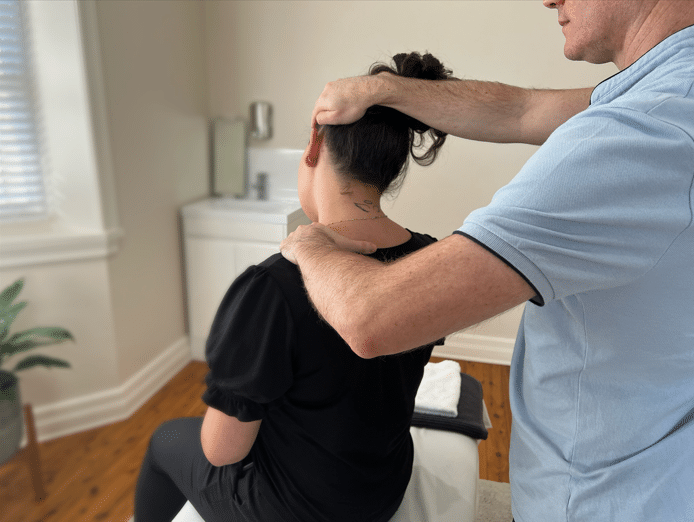- 02 9712 1736
- [email protected]
- 212 Great North Road, Five Dock, NSW 2046
- Open 7 days a week
We’ve all experienced that annoying crick in our neck after sleeping wrong or spending too long hunched over our phones. Most of the time, neck pain is just your body’s way of saying “hey, take a break!” But sometimes—and this is important—neck pain can be a warning sign that something more serious is going on. Think of these warning signs as “red flags” waving to get your attention. Understanding these red flags could be the difference between treating simple muscle strain and catching a condition that needs immediate medical care.

Before we dive into neck-specific red flags, let’s talk about what doctors mean when they say “red flags.” In medicine, red flags are symptoms that make healthcare providers think, “Hold on, we need to look deeper into this.” They’re like warning lights on your car’s dashboard—they don’t always mean disaster is coming, but they definitely mean it’s time for a check-up.
Recent medical research shows that about 1% of neck pain cases are caused by serious underlying conditions like cancer, infections, or spinal cord problems. While that might sound scary, it actually means 99% of neck pain is from everyday causes like poor posture, stress, or minor muscle strain.
Based on the latest clinical research from 2024, here are the key warning signs that should prompt you to see a doctor sooner rather than later:
If you’ve been in a car accident, had a bad fall, or experienced any trauma that could have hurt your spine, don’t wait to get checked out. Doctors can identify “red flags” that may signify serious pathology, such as myelopathy, atlantoaxial subluxation, and metastases. Even if you feel “mostly okay,” your neck contains delicate structures that can be injured in ways you might not immediately notice.
When neck pain comes with fever, chills, or feeling generally unwell, it could signal an infection. This is especially important for people with diabetes or weakened immune systems. The suggested red flags by the Neck Pain Task Force include infections, cervical myelopathy, and previous neck surgery.
Pay attention if your neck pain comes with severe headaches that feel different from your usual headaches, or if you experience numbness, tingling, or weakness in your arms or hands. These could indicate problems with your spinal cord or nerves.
If you’re losing weight without trying to diet or exercise more, and you have persistent neck pain, this combination warrants medical attention. Unexpected weight loss can sometimes be an early sign of serious conditions.
Most neck pain gets better within a few days to weeks with rest and gentle movement. If your pain is severe, getting worse instead of better, or has lasted more than six weeks without improvement, it’s time to see a healthcare provider.
If you have a history of cancer, autoimmune diseases like rheumatoid arthritis, or osteoporosis, be extra cautious about new or worsening neck pain. Certain comorbid disorders and patient factors increase the risk of cervical spine conditions.
You might be wondering why doctors are so concerned about these particular symptoms. The reason is that your neck houses some pretty important stuff—your spinal cord, major blood vessels, and nerves that control everything from your arms to your breathing. When something goes wrong in this area, quick treatment can prevent permanent damage.
The good news? Recent research shows that red flags were mainly supported by expert opinions, meaning doctors have developed these guidelines based on years of clinical experience, even if we don’t have perfect tests for every situation.
If you notice any of these red flags, don’t panic, but don’t ignore them either. Make an appointment with your doctor or visit an urgent care center. Be prepared to describe:
Remember, most neck pain is not dangerous. Most episodes of acute neck pain will resolve with or without treatment, but nearly 50% of individuals will continue to experience some degree of pain or frequent occurrences. But being aware of red flags helps ensure you get the right care at the right time.
While we’re talking about neck pain, let’s touch on prevention. Simple habits like maintaining good posture, taking regular breaks from screens, sleeping with proper neck support, and managing stress can go a long way in preventing neck problems. Regular gentle stretching and strengthening exercises can also help keep your neck healthy and resilient.

Neck pain is incredibly common, and most of the time it’s nothing to worry about. However, knowing the red flags—injury-related pain, fever and illness, severe headaches with neurological symptoms, unexplained weight loss, persistent worsening pain, and pain in people with certain medical histories—can help you make smart decisions about when to seek medical care. When in doubt, it’s always better to check with a healthcare provider. Your neck does a lot of important work, and it deserves proper care and attention.


About
Five Dock Osteopathic & Chiropractic is located in Canada Bay, in Sydney’s Inner West. Servicing suburbs including Burwood, Croydon, Drummoyne, Five Dock, Haberfield, Concord, Abbotsford, Chiswick, Leichhardt, Wareemba, Russell Lea, Summer Hill, Strathfield.
Clinic hours
Monday, Tuesday, Thursday 7AM – 7PM
Wednesday, Friday 7AM – 6PM
Saturday 7AM – 2PM
Sunday 8AM – 2PM
Contact details